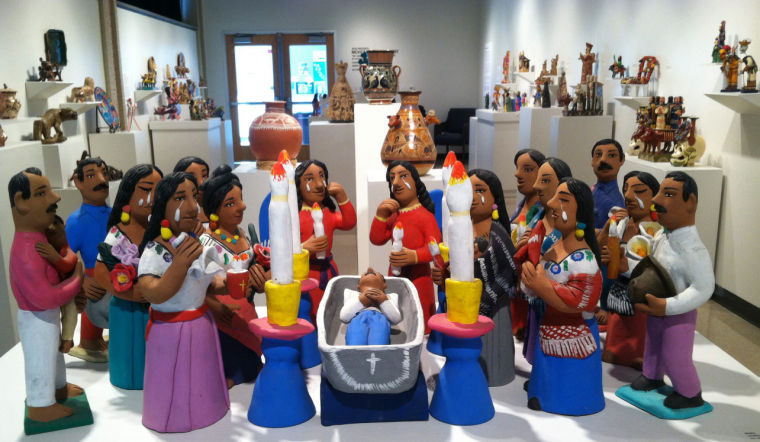“Mexican Visions” offers exploration of diverse folk art images
Exploring the collections of ceramic pieces from the exhibit “Mexican Visions in Clay, The Sacred, Secular and Fantastical in Figurative Art” gives a renewed perspective on a rich cultural history.
Merry Wheaton, Austin Friends of Folk Art member, spoke on the differences between Mexican and Mexican American folk art.
“Mexican art has a straighter line into its heritage. I see a lot of diversity [there]. One thing I noticed about Mexican American art is that there is a lot of diversity but it combines the Mexican culture and the US culture,” Wheaton said.
“Most of the imagery that appears in Mexican American folk art is of icons. You have the Virgin Mary, wrestlers, Day of the Dead. These are very iconic images as appose to farmers, people on Ferris wheels, things that are drawn from the experience from someone living in Mexico.”
Catholic imagery encompasses all of the sacred sculptures. Surprisingly, one of the more famous icons, la Virgen de Guadalupe, was not present in any form. Common icons like a nativity and angels catch the eye quickly, but the more obscure icons were also compelling.
First-time viewers might not know of different patron virgins like San Juan de los Lagos and La Virgen de la Soledad are far more familiar to those who studied Catholicism through a Latin lens.
These icons dominated two-thirds of the gallery, and for good reason. Mexico’s Catholic population remains strong and Mexican citizens feel the influences every day.
Wheaton explained how religion affects traditions familiar to Mexican Americans but celebrated in slightly different ways.
“In the Mexican Christmas tradition, you put up a Nacimiento [nativity scene] and everybody is there. You have market ladies, dancers, bandidos [bandits], and even the devil hiding behind the bush,” Wheaton said. “Everybody is there because that is the story of Christmas.”
Though secular and fantastic sculptures differ in their criteria, there were some sculptures placed in the secular portion that felt more fantastical. Sculptures specific to the secular portion of the exhibit ranged from animals, such as mice and jaguars with exaggerated features, to plates and jars depicting farm and nature life.
A violent scene depicting the hanging of adulterers, consumed by fire and damned by devils, tends to fit more with sculptures of mermaids and naguals [shape-shifting spirits]. The aesthetics, though different in style, transcend the labels associated with the gallery.
The unique styles and variety of sculptural forms at “Mexican Visions” show the diversity of Mexican culture to which simple labels cannot do justice.







